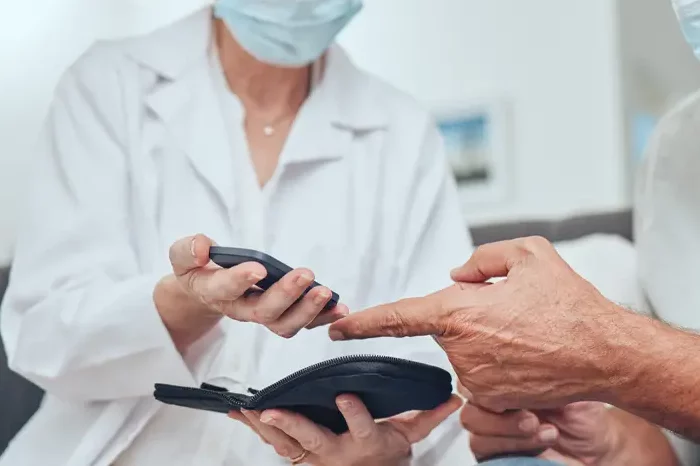Understanding Type 2 Diabetes
Pathophysiology of Type 2 Diabetes
Type 2 diabetes primarily involves:
Insulin Resistance: The body’s cells become less responsive to insulin, a hormone that facilitates the uptake of glucose into cells for energy production.
Insufficient Insulin Production: Over time, the pancreas may produce less insulin, exacerbating the problem of high blood glucose levels.
Diagnosis of Type 2 Diabetes
Type 2 diabetes is diagnosed through various tests, including:
Fasting Plasma Glucose Test: Measures blood glucose after an overnight fast. A level of 126 mg/dL (7.0 mmol/L) or higher indicates diabetes.
Hemoglobin A1c Test: Reflects average blood glucose levels over the past 2-3 months. An A1c level of 6.5% or higher suggests diabetes.
Oral Glucose Tolerance Test: Measures blood glucose before and after consuming a sugary drink. A 2-hour glucose level of 200 mg/dL (11.1 mmol/L) or higher indicates diabetes.
Hyperglycemia in Type 2 Diabetes
Causes of Hyperglycemia
Hyperglycemia is a hallmark of type 2 diabetes and can result from:
Insufficient Insulin Production: The pancreas doesn’t produce enough insulin to regulate blood glucose levels.
Insulin Resistance: Cells in the body don’t respond effectively to insulin.
Diet: Consuming foods high in carbohydrates or sugars can lead to elevated blood glucose levels.
Physical Inactivity: Lack of exercise can contribute to insulin resistance.
Stress: Both physical and emotional stress can increase blood glucose levels.
Illness: Infections or other illnesses can cause blood glucose to rise.
Symptoms of Hyperglycemia
Common symptoms of hyperglycemia include:
- Frequent urination
- Increased thirst
- Blurred vision
- Fatigue
- Headaches
- Difficulty concentrating
If hyperglycemia persists, it can lead to more severe complications, such as diabetic ketoacidosis (DKA) or hyperosmolar hyperglycemic state (HHS), both of which require immediate medical attention.
Managing Hyperglycemia
Managing hyperglycemia involves:
Medication: Taking prescribed diabetes medications or insulin as directed.
Dietary Changes: Following a balanced diet with controlled carbohydrate intake.
Exercise: Regular physical activity to help improve insulin sensitivity.
Monitoring Blood Sugar: Regularly checking blood glucose levels to identify patterns and adjust treatment as necessary.
Hypoglycemia in Type 2 Diabetes
Causes of Hypoglycemia
Although hyperglycemia is more common, hypoglycemia can occur in individuals with type 2 diabetes, especially those on insulin or certain oral medications. Causes include:
Medications: Insulin or sulfonylureas can cause blood glucose levels to drop too low.
Skipping Meals: Not eating enough food, especially carbohydrates, can lead to low blood sugar.
Excessive Exercise: Intense or prolonged physical activity can lower blood glucose levels.
Alcohol Consumption: Drinking alcohol, particularly on an empty stomach, can cause hypoglycemia.
Symptoms of Hypoglycemia
Symptoms of hypoglycemia range from mild to severe and can include:
- Shakiness or trembling
- Sweating
- Dizziness or lightheadedness
- Hunger
- Irritability or mood changes
- Confusion or difficulty concentrating
- Weakness or fatigue
- Blurred vision
- Severe cases may result in seizures, loss of consciousness, or even death if not treated promptly.
Managing Hypoglycemia
Immediate treatment for hypoglycemia involves consuming fast-acting carbohydrates, such as:
- Glucose tablets or gel
- Fruit juice
- Regular soda (not diet)
- Hard candy
- Honey or sugar
Preventive measures include:
Regular Meals and Snacks: Eating consistent meals and snacks that include carbohydrates.
Monitoring Blood Sugar: Checking blood glucose levels regularly to detect and treat lows early.
Adjusting Medications: Working with a healthcare provider to adjust medication doses if hypoglycemia occurs frequently.
Education: Understanding the signs and symptoms of hypoglycemia and knowing how to respond appropriately.
The Balance Between Hyperglycemia and Hypoglycemia
Challenges in Managing Type 2 Diabetes
Balancing blood glucose levels in type 2 diabetes involves managing both hyperglycemia and hypoglycemia. Key challenges include:
Medication Management: Ensuring that medications effectively control blood glucose without causing lows.
Diet and Exercise: Maintaining a consistent diet and exercise routine that supports stable blood sugar levels.
Monitoring: Regular blood glucose monitoring to identify and address fluctuations.
Individual Variation: Each person’s response to treatment and lifestyle changes can vary, requiring personalized management plans.
Strategies for Optimal Blood Glucose Control
Effective strategies for managing blood glucose levels in type 2 diabetes include:
Personalized Treatment Plans: Working with healthcare providers to develop individualized treatment plans that address specific needs and goals.
Patient Education: Providing education on diet, exercise, medication, and blood glucose monitoring.
Support Systems: Utilizing support from healthcare professionals, diabetes educators, and peer support groups.
Technological Aids: Using technology such as continuous glucose monitors (CGMs) and insulin pumps to help manage blood glucose levels more effectively.
See also: What Destroys the Beta Cells in the Pancreas
Conclusion
Type 2 diabetes is primarily characterized by hyperglycemia, but individuals with this condition can also experience hypoglycemia, especially when using certain medications. Understanding the causes, symptoms, and management strategies for both hyperglycemia and hypoglycemia is crucial for effective diabetes management.
Managing type 2 diabetes requires a comprehensive approach that includes medication, dietary changes, regular exercise, and ongoing monitoring of blood glucose levels. By balancing these factors and working closely with healthcare providers, individuals with type 2 diabetes can achieve better blood glucose control and reduce the risk of complications.
Education and support play vital roles in managing type 2 diabetes. Empowering patients with knowledge and resources enables them to make informed decisions and take proactive steps in their diabetes care. By understanding the relationship between type 2 diabetes, hyperglycemia, and hypoglycemia, individuals can navigate the complexities of this condition and improve their overall health and well-being.
Related topics:
What’s the Best Coffee for Diabetics


























